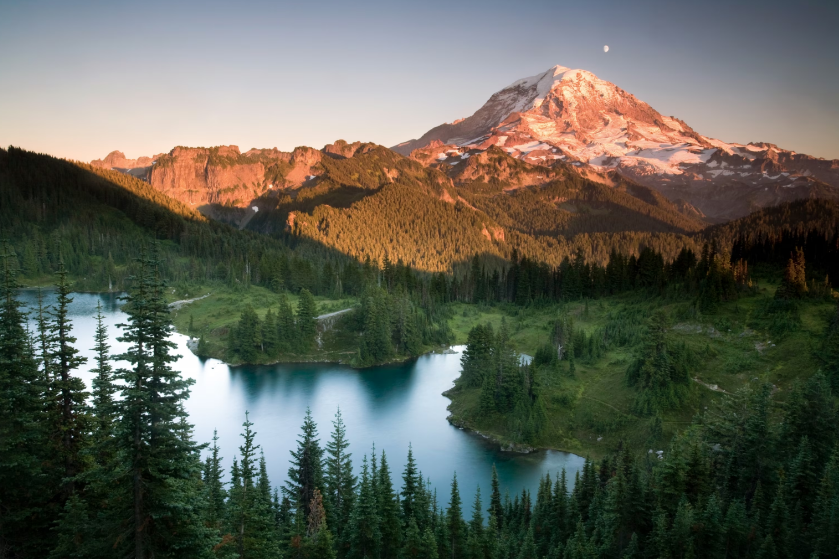Mount Rainier, a towering giant in Washington state, stands at an impressive 4.3 kilometers (2.7 miles) above sea level. This snowcapped peak has remained dormant for over a thousand years, but its potential threat to nearby communities surpasses that of Hawaii’s active lava fields and Yellowstone’s vast supervolcano.
In a recent episode of CNN’s Original Series, “Violent Earth With Liv Schreiber,” Jess Phoenix, a volcanologist and representative for the Union of Concerned Scientists, expressed her apprehension about Mount Rainier’s potential threat. She stated, “Mount Rainier keeps me up at night because it poses such a great threat to the surrounding communities. Tacoma and South Seattle are built on 100-foot-thick (30.5-meter) ancient mudflows from eruptions of Mount Rainier.”
The primary danger posed by Mount Rainier is not from fiery lava flows but from the possibility of lahars—fast-moving mixtures of water and volcanic rock caused by rapid ice or snow melting during an eruption. These lahars can gather debris and wreak havoc as they surge through valleys and drainage channels.
Seth Moran, a research seismologist at USGS Cascades Volcano Observatory, noted the unique challenges posed by Mount Rainier. “The thing that makes Mount Rainier tough is that it is so tall, and it’s covered with ice and snow,” he said. “If there is any kind of eruptive activity, hot stuff will melt the cold stuff and a lot of water will start coming down. And there are tens, if not hundreds of thousands of people who live in areas that potentially could be impacted by a large lahar, and it could happen quite quickly.”
The devastating potential of lahars was demonstrated in November 1985 when an eruption from Colombia’s Nevado del Ruiz volcano resulted in a deadly lahar that killed over 23,000 people. Mount Rainier, with approximately eight times the amount of glaciers and snow as Nevado del Ruiz had at the time, poses a risk for an even more disastrous mudflow.
Mount Rainier was ranked as the third most hazardous US volcano in the US Geological Survey’s latest threat assessment from 2018, following Hawaii’s Kīlauea and Mount St. Helens. Lahars typically occur during volcanic eruptions but can also be triggered by landslides and earthquakes. Historical evidence reveals that at least 11 large lahars from Mount Rainier have reached the Puget Lowlands over the past 6,000 years, with the most recent one occurring about 500 years ago, likely due to a landslide rather than volcanic activity.
The site of the last major lahar still contains loose, weak rock, and it is this potential for another spontaneous landslide-triggered lahar that concerns volcanologists like Moran. He said, “There’s the knowledge now that the volcano is potentially capable of doing it again. And then we’re in this world of it could happen at any time.”
A study conducted in 2022 modeled two worst-case scenarios. In the first, a lahar equivalent to 104,000 Olympic-size pools could reach Orting, Washington’s densely populated lowlands within an hour, moving at a speed of 13 feet (4 meters) per second. The second scenario involves the Nisqually River Valley where a massive lahar could displace enough water from Alder Lake to cause Alder Dam’s 100-meter height to overflow.
Mount Rainier’s relative, Mount St. Helens, caused a catastrophic lahar during its eruption four decades ago. Venus Dergan and Roald Reitan, who were camping at the time, survived this deadly mudflow, highlighting the lethal nature of these events.
To mitigate these risks, the US Geological Survey established a lahar detection system at Mount Rainier in 1998, which has since been improved. There are now about 20 sites on the volcano’s slopes and paths most at risk of lahars equipped with advanced sensors, including broadband seismometers, trip wires, infrasound sensors, web cameras, and GPS receivers.
In March, nearly 45,000 students from five Washington school districts participated in a lahar evacuation drill, the largest such drill in the world. Approximately 13,000 students walked up to 3.2 kilometers (2 miles) to designated safe locations while others practiced sheltering in place.
Moran stressed the importance of readiness: “Most of what happens at volcanoes is close by, and that’s why you try to keep people away because things happen fast, but lahars can travel a long way from the volcano and have a big impact.”
The real-time data from the detection system, coupled with community preparedness drills, aims to lessen the impact of a potential lahar by ensuring rapid evacuation and safety for the tens of thousands of people living in Mount Rainier’s shadow.
Source: Red Right Newsfeed


Leave a Comment